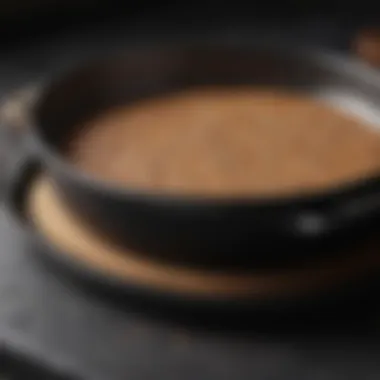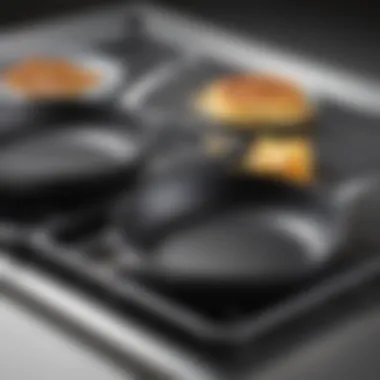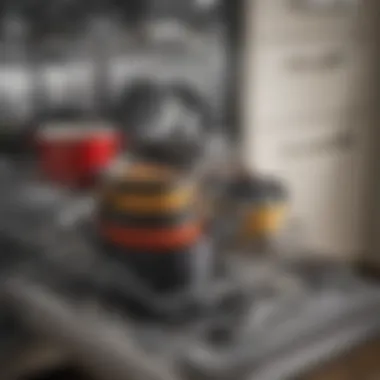Understanding Non-Stick Pans: Dishwasher Safety Insights


Intro
The query surrounding the dishwasher safety of non-stick pans is frequent among culinary enthusiasts. Many people invest in non-stick cookware expecting easy maintenance. However, uncertainties linger regarding optimal care practices on brightly colored packaging. Monitoring the materials used in non-stick pans is critical. Non-stick surfaces vary greatly, which can affect their performance and longevity. This understanding is essential for anyone wanting to keep their non-stick cookware in prime condition.
In this article, we delve deeply into the dangers and merits of using a dishwasher with non-stick pans. We will also discuss cleaning methods and care tips that could maximize the lifespan of your cookware.
Non-Stick Pan Materials
Non-stick pans generally consist of a base material coated with various non-stick coatings. Most common coatings include Teflon, ceramic, and anodized aluminum. Each comes with unique characteristics.
Teflon Coated Pans
Teflon is perhaps the most recognized non-stick coating. It allows cooking with minimal oil, making food preparation healthier. However, improper dishwashing practices can wear down the coating. Consequently, most manufacturers recommend hand washing
Ceramic Coated Pans
Ceramic coatings have gained popularity for their scratch resistance and chemical-free nature. Still, dishwashing can harm the finish, reducing its stick-resistance over time. Hand washing is often better to preserve the surface of ceramic non-stick pans.
Anodized Aluminum Pans
Anodized aluminum pans offer durability against scratches and high heat. While more resilient than other types, there's always a risk of scratching the non-stick surface in a dishwasher. Thus, a gentler approach is must for maintenance.
Implications of Using Dishwashers
The use of dishwashers introduces various elements that can be damaging to non-stick cookware.
- Heat and Moisture: High temperatures keep the dishes clean but can compromise the non-stick coating over time.
- Detergents: Many detergents contain harsh chemicals that are abrasive. Automatic dishwashers can create an environment that is overly aggressive for these coatings.
- Physical Contact: Other kitchenware items inside the dishwasher may rub against and scratch non-stick surfaces.
To optimize care and use of non-stick pans, alternative cleaning methods are necessary instead of relying solely on dishwashers.
Proper Care and Maintenance of Non-Stick Pans
To prolong the life of non-stick pans, suitable cleaning and maintenance techniques should be practiced. Here are some insights into effective cleaning strategies:
- Hand Wash: Use warm, soapy water and a gentle sponge to clean. Avoid steel wool or harsh scrubbers.
- Dry Completely: Water expand metal but can degrade coatings. So always dry before storing, particularly stacked with other pots.
- Use Wooden or Silicone Utensils: Metal utensils can scratch the coating, so choosing appropriate kitchen tools is essential.
Keeping non-stick pans in good condition not only enhances cooking practices but also assures a safer kitchen environment overall. Proper care bestows excellent cooking experiences for years.
Remember, investing in high-quality cookware comes with the responsibility of obtaining proper maintenance to maximize both functionality and safety.
Prolusion to Non-Stick Cookware
Non-stick cookware has become integral to modern kitchens. It introduces ease into cooking, making food release simple and clean-up more efficient. Understanding non-stick cookware involves not just knowing how they function, but also grasping the implications for daily use, that is relevant for every cooking enthusiast.
Choosing non-stick pans means accounting for several unique features. Non-stick coatings can reduce the need for excessive oils and fats, leading to a healthier cooking method. Also, its smooth surface serves to enhance overall cooking efficiency.
Yet, there are considerations. Users must be aware of the materials used, the inherent risks associated with prolonged use, and questions about maintenance practices, especially around whether these items can survive dishwashers. Addressing these key issues can lead to better informed decisions for those investing in non-stick cookware.
Definition of Non-Stick Cookware
Non-stick cookware refers to cooking tools that utilize a coating to prevent food from adhering to the surface. Although various materials can be used to achieve this effect, the general purpose is maintaining an easy release when cooking and a simpler cleanup process.
The most common form of non-stick technology involves coatings such as polytetrafluoroethylene, popularly identified as Teflon. This makes frying and sautéing foods a smooth process, with less risk of burning or sticking. Such advancements in material science have made it possible to create pans and pots that are significantly easier to handle in day-to-day cooking.
History of Non-Stick Technologies


The origin of non-stick cookware dates back to the 20th century. The invention of Teflon by chemist Roy Plunkett in 1938 marked the beginning of non-stick surfaces in cookery. In the decades that followed, manufacturers took to modernizing kitchen tools, introducing these coatings to various forms of cookware.
As the technology matured, manufacturers explored a variety of materials and coatings, leading to alternatives such as ceramic and anodized aluminum. These provided safer options while maintaining the essential non-stick property, aiming to combine usability and aesthetic appeal.
Overall, the journey from rudimentary cooking vessels to sophisticated non-stick cookware is a testament to human ingenuity that constantly seeks improvement in everyday tasks.
The Mechanics of Non-Stick Surfaces
Understanding the mechanics behind non-stick surfaces is key to grasping their effectiveness and maintenance. The choice of materials used in these surfaces signifies not just the ease of cooking but also the long-term utility of the cookware in your kitchen. Saving time and effort during cooking and cleaning contributes to a more enjoyable culinary experience. Therefore, exploring these coatings and materials can help you make informed decisions about your cookware.
Common Coatings and Materials
The structures of non-stick pans differ based on the materials used. Some of the most recognized and widely used coatings are PTFE (Teflon), ceramic coatings, and anodized aluminum.
PTFE (Teflon)
PTFE, popularly known as Teflon, is one of the most recognized materials employed in non-stick cookware. Its primary characteristic is excellent non-stick properties, which ensure food slides off effortlessly, reducing the need for excessive oil or fat. The smooth surface of Teflon allows for easy food release during cooking, making cleanup much simpler.
However, one key aspect to consider is that when Teflon is scratched, its non-stick properties can diminish. Teflon also requires specific care to maintain its integrity and non-stick performance. While PTFE is overall a durable material, extremely high temperatures can lead to degradation. Therefore, using minimalist heat settings focus is recommended with Teflon to maximize its lifespan.
Ceramic Coatings
Ceramic coatings became a popular alternative for those seeking a different kind of non-stick surface. They are derived from inorganic materials, giving them a natural non-stick factor without PTFE. One major advantage of ceramic coatings is their resistance to high temperatures, making them a viable option for diverse cooking methods.
Another notable benefit includes an ease of clean-up enhanced by the non-toxic surface layer. Because of their composition, these coatings are typically considered safer for higher-temperature cooking. Nevertheless, ceramic cookware often requires careful usage as they can be prone to chipping or cracking if subjected to abrupt impacts.
Anodized Aluminum
Anodized aluminum cookware is another popular alternative in the non-stick realm. The process of anodization alters the aluminum structure, creating a hard, durable surface. This surface does provide a degree of non-stick functionality. It can ensure even heat distribution, which is critical when preparing various dishes.
What's unique about anodized aluminum is that while its non-stick properties may not match those of Teflon or ceramic for some specific interactions or foods, it offers robust durability against scratching and wear. Some prefer anodized aluminum not only because of its lighter weight compared to traditional non-stick pans but also for its high resistive capacities against corrosion and rust over time.
The Science Behind Non-Stick Properties
At the core of non-stick properties lie two principles: surface tension reduction and chemical make-up. Surface modifications create low-energy surfaces where food particles do not adhere. Over time, advancements in scientific technologies and new composite materials continuous to evolve non-stick options.
“Keeping non-stick surfaces scratch-free and using appropriate utensils can prevent performance devaluations.”
Not only does understanding how non-stick surfaces work improve cooking techniques, but it can also encourage better care practices, ultimately promoting the longevity of cookware. Each type of coating has roots in meticulously crafted technology that reaffirms the choice you make for your kitchen essentials.
Dishwasher Safety: The Core Question
When it comes to non-stick cookware, the question of dishwasher safety is significant for anyone evaluating their kitchen routines. Many consumers prefer dishwashers for their convenience. However, it is crucial to understand that non-stick pans, often designed for easy cleaning, still require specific care to maintain their functionality and longevity.
Aside from questions about the kitchen’s efficiency, using a dishwasher can alter chemical compounds and physical structures in these pans. The impacts of heat, steam, and detergents can be counterproductive to preserving non-stick surfaces. Understanding these factors can help informed culinary enthusiasts make better choices about their cookware.
Are All Non-Stick Pans Dishwasher Safe?
This question is not as simple as it may seem. Not all non-stick pans are dishwasher safe, and their ability to withstand the rigorous environments of a dishwasher often depends on their specific materials and coatings.
Generally, pans made with Teflon or ceramic coatings might have varying levels of dishwasher compatibility.[^1] While some manufacturers state that their products can endure dishwashing, others may encourage hand washing to retain non-stick properties.
It is best practice to examine the barcode or descriptions before litigation, as there is significant variance amongst manufacturers.
Manufacturer Guidelines


Manufacturer guidelines serve as a reliable source of information for non-stick cookware care. Different brands like Scanpan or Calphalon offer specific instructions on their products.
Some guidelines specify:
- Always check labels for dishwasher compatibility before cleaning your pan.
- If they recommend it, place non-stick pans on the top rack only to minimize exposure to intense heat.
- Use mild detergents and avoid strong cleaning solutions that may degrade the surface more.
Following these instructions can optimize your refreshment routines while looking after your kitchen investment carefully.
Common Misconceptions
Misconceptions affect how people treat their non-stick cookware. Below are critical points to consider:
- Misconception 1: All non-stick pans are dishwasher friendly. Many users assume all non-stick pans share similar properties, leading to misinformed cleaning practices.
- Misconception 2: It’s safe to place non-stick cookware in the dishwasher always.
As mentioned earlier, even pans that resist dishwasher treatment can suffer degradation over time, affecting their longevity. - Misconception 3: Scratched non-stick surfaces are ok to clean in the machine.
Expert advice warns against dishwashing scratched non-stick pans because it can exacerbate damage or release harmful materials.
Carefully considering scientifically backed information and manufacturer guidelines is paramount for maintaining these essential kitchen tools.
Hence, for best maintenance results, handwashing is often a preferred method unless explicitly stated otherwise.
By retaining this knowledge, culinary enthusiasts can enhance their kitchens and operate more effectively.
[^1]: Wikipedia on Non-Stick Cookware
Understanding Dishwashing Processes
Understanding how dishwasher processes work is crucial for effectively maintaining non-stick pans. Improper use can lead to quicker wear and tear of the coatings, reducing the lifespan of your cookware. Familiarity with the functions of dishwashers informs dishwasher use, impacting not only the cleanliness of the pans but also their integrity over time.
How Dishwashers Operate
Dishwashers function by spraying water mixed with detergent onto dirty dishes at high temperatures. The cycle typically includes several stages:
- Pre-Rinse or Soak Phase: Warm water removes large food debris.
- Washing Phase: Sprays pressurized jets of soapy water at high speeds.
- Rinse Phase: Fresh water eliminates residual soap and food particles.
- Drying Phase: Heat or air dries the items thoroughly.
This process uses a combination of pressure, water temperature, and chemicals. Non-stick surfaces can be compromised by the high-pressure water jets and harsh messages if the pans are not designed to withstand them.
Impact of High Temperatures and Detergents
High temperatures and aggressive detergents affect non-stick pans in various ways. High temperatures during the washing cycle can pose a considerable risk to non-stick coating durability. Conventional non-stick materials like PTFE (Teflon) can degrade if exposed repeatedly to intense heat. Beyond exposure, certain chemical detergents reinforce damaging agents.
Factors to consider for safe dishwasher use include:
- Temperature settings: High settings can warp your pans.
- Detergent type: Some are too abrasive for delicate coatings.
- Duration of cycle: Longer cycles might subject pans to unnecessary stress.
A careful understanding of these factors helps in determining whether a dishwasher is adequate for specific non-stick cookware. Always default to manufacturer’s guidelines over general dishwasher patterns.
Best Practices for Maintaining Non-Stick Pans
Maintaining non-stick pans is crucial for prolonging their lifespan and keeping them in good condition. The reputation of such cookware as easy-to-use relies partly on proper care methods. If these pans are not cared for properly, it can lead to scratching, loss of the non-stick surface, and even health concerns in rare instances. Knowing best practices will enhance the quality of cooking and protect your investment.
Proper Cleaning Techniques
When it comes to cleaning non-stick pans, opting for gentler methods ensures the longevity of the cookware. Here are some key approaches:
- Avoid Metal Utensils: Use silicone, wood, or plastic utensils to stir or scrape food. Metal utensils can easily scratch the non-stick coating, compromising its effectiveness.
- Hand Washing: Although some non-stick pans may claim to be dishwasher safe, hand washing is often gentler. Use warm soapy water with a soft sponge. Tackle food residue by letting the pan soak briefly before scrubbing.
- Avoid Abrasive Cleaners: Stay clear of steel wool or abrasive pads. They can damage the non-stick surface, leading to poor performance and contamination risks.
- Dry Immediately: After rinsing, dried water spots can affect cooking temperature. Quickly hand dry with a soft cloth or paper towel to remove excess moisture.
These methods assist not only in keeping non-stick pans functional but also in safeguarding your health and improving your cooking experience. Maintaining their non-stick properties can be uncomplicated with consistent efforts.


When to Hand Wash vs.
Dishwasher
Many cooks may wonder whether to utilize the dishwasher for cleaning non-stick pans. While washing in a dishwasher can seem convenient, the choice is not always favorable. Here are some considerations:
- Manufacturer’s Instructions: Always refer to manufacturer guidelines. Many brands recommend hand washing for non-stick cookware to avoid wear from intense washing cycles.
- Durability of Coating: If the non-stick coating is particularly delicate, or if the pan is older, hand washing is wiser. Dishwashers subject cookware to harsher environments, which may degrade the coating.
- Type of Food Residue: If a pan is heavily soiled post-use, hand washing may tackle stuck food better compared to a dishwasher. Spray types of detergents in a domestic dishwasher can fall short in rinsing adequately with baked-on food.
- Loading Dishes: Crushing or leaning during the loading process can create scratches. If using a dishwasher is still preferred, ensure no other dish will contact the pans directly.
Alternatives to Dishwashing
The discussion surrounding non-stick pans often leads to the question of dishwasher safety; however, understanding the alternatives to dishwashing can prove just as pivotal for preserving the longevity of your cookware. Power margin is important, of course, dictated by specific baking and frying preferences, where usage impacts cleaning methods. Taking proper care of non-stick pans assures that they remain an valuable tool in your kitchen, saving you from the potential damage silence improperly using a dishwasher might inflict.
Given the varying types of non-stick coatings, such as PTFE (Teflon) and ceramic, it is crucial to adapt cleaning methods accordingly. Choosing the right option not only maintains the integrity of the surface, it enhances food release properties that are ideally desired. Furthermore, taking care of your non-stick tools can prolong their lifespan, ultimately saving you money over time.
Recommended alternatives include thoughtful strategies for manual cleaning, ensuring that your pan receives the attention it merits. Here are some key points to think about:
- Understanding specific needs: Identify your cookware materials.
- Regular care: Make cleaning a routine to evade buildup.
- Potential damage from dishwasher cycles: Recognizing its limitations is important to avoid.
Overall, understanding the options other than dishwashing significantly contributes to making informed decisions. Embracing these methods allows you to enjoy your non-stick pans much longer.
Manual Cleaning Methods
In practical terms, manual cleaning methods are often superior for maintaining non-stick pans when compared to the average dishwasher cycle. In fact, most culinary experts suggest that gentle hand washing is the best mode of preservation. A basic routine is enough to keep your cookware in pristine shape.
First, use a soft sponge or cloth together with mild dish soap. Avoid abrasive scrubbing tools, which can create scratches on non-stick surfaces and diminish their expected performance.
Steps for effective hand cleaning include:
- Allow the pan to cool down completely after use.
- Rinse the pan with warm water to alleviate any leftover food.
- Use a soft sponge with a conservative amount of dish soap to clean the surface gently.
- Rinse thoroughly and dry with a clean towel to prevent water spots or drips.
Tip: Avoid soaking non-stick pans in water for extended periods. It can break down the coating over time. Adopting this gentle approach consistently will lead to optimal performance.
Safe Products for Non-Stick Care
Choosing the right products is essential for the cleaning and maintenance of non-stick pans. Certain detergents and cleaning agents can interfere with the non-stick coating elements, presenting risks for damaging your cookware. Below are options considered safe and effective:
- Mild dish soap: A gentle, non-abrasive detergent can facilitate thorough cleaning.
- Baking soda: This arises as a notable option for mild scrubbing without the harsh impact. Create a paste with a small amount of water for stubborn stains.
- Vegetable oil: Applying a thin layer onto a clean surface can help restore some non-stick properties since it decreases abrasion during cooking.
Look out for important labels before using any cleaner, as ingredients must be non-toxic and safe. Products with overpowering chemicals can misbalance cooking safety and cookware functionality, leading to a poor culinary experience. We can recommend avoiding products with strong acids or abrasive fibers. Keeping this relationship with your non-stick wares respectful opens the avenue for robust kitchen expression.
Ending
To conclude the discussion on non-stick pans and their dishwasher safety, it is essential to emphasize the significance of the topic in relation to cookware care. Non-stick pans have become an integral part of many kitchens, valued for their efficiency and ease of use. Understanding their maintenance, particularly concerning whether they can be placed in a dishwasher, profoundly impacts their longevity and performance.
Summarizing Key Points
First, it must be recognized that not all non-stick pans are created equal. The materials used vary, influencing whether a pan can withstand dishwasher conditions. High temperatures and harsh detergents can compromise the integrity of the non-stick coating. For instance:
- PTFE (Teflon): can be sensitive, leading to potential degradation when exposed to extreme heat typical in dishwashers.
- Ceramic: often touted for stronger resilience, though care must still be exercised.
- Anodized Aluminum: generally more durable but can still require proper care to preserve the non-stick properties.
Emphasizing the manufacturer's guidelines is paramount. They offer insights into tech specs and coatings that dictate dishwash capabilities. Furthermore, debunking misconceptions surrounding this subject provides clarity. Many believe any non-stick pan can simply be tossed into a dishwasher. However, such assumptions neglect varied engineering behind these products.
Carrying an understanding of how dishwashers operate, particularly the impact of high temperatures and detergents, can change one's approach to dishwashing non-stick cookware.
The Future of Non-Stick Cookware
Looking ahead, innovations in reseach may result in even more advanced non-stick coatings. As the demand for eco-friendly and health-conscious materials increases, future non-stick pans could incorporate safer substances while enhancing durability. These innovations might also branch out towards managing heat distribution, ultimately providing improved cooking solutions.
Moreover, further studies will likely investigate the implications of dishwasher use versus hand washing without causing wear. Therefore, consumer awareness and education about cookware care will be prioritized. Adapting habits to accommodate emerging products in the kitchen will be crucial for enthusiasts who aim for ideal cooking results.
The importance of this topic cannot be understated. Understanding the nuances in non-stick cookware maintenance not only serves to extend the life of these essential kitchen tools but also contributes to a more effective culinary journey.







